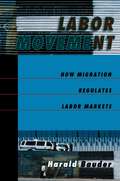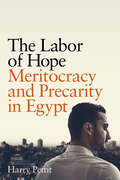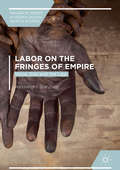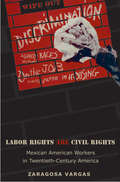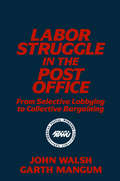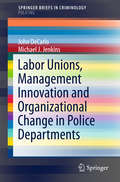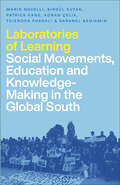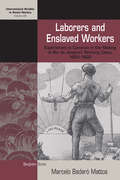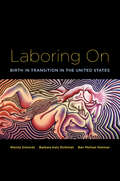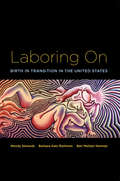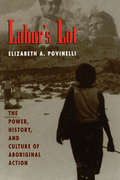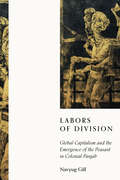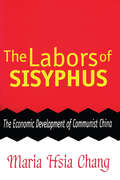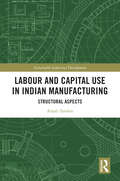- Table View
- List View
Labor Movement: How Migration Regulates Labor Markets
by Harald BauderThroughout the industrialized world, international migrants serve as nannies, construction workers, gardeners and small-business entrepreneurs. Labor Movement suggests that the international migration of workers is necessary for the survival of industrialized economies. The book thus turns the conventional view of international migration on its head: it investigates how migration regulates labor markets, rather than labor markets shaping migration flows. Assuming a critical view of orthodox economic theory, the book illustrates how different legal, social and cultural strategies towards international migrants are deployed and coordinated within the wider neo-liberal project to render migrants and immigrants vulnerable, pushing them into performing distinct economic roles and into subordinate labor market situations. Drawing on social theories associated with Pierre Bourdieu and other prominent thinkers, Labor Movement suggests that migration regulates labor markets through processes of social distinction, cultural judgement and the strategic deployment of citizenship. European and North American case studies illustrate how the labor of international migrants is systematically devalued and how popular discourse legitimates the demotion of migrants to subordinate labor. Engaging with various immigrant groups in different cities, including South Asian immigrants in Vancouver, foreigners and Spätaussiedler in Berlin, and Mexican and Caribbean offshore workers in rural Ontario, the studies seek to unravel the complex web of regulatory labor market processes related to international migration. Recognizing and understanding these processes, Bauder argues, is an important step towards building effective activist strategies and for envisioning new roles for migrating workers and people. The book is a valuable resource to researchers and students in economics, ethnic and migration studies, geography, sociology, political science, and to frontline activists in Europe, North America and beyond.
The Labor of Hope: Meritocracy and Precarity in Egypt
by Harry PettitTechnological advancements, expanding education, and unfettered capitalism have encouraged many around the world to aspire to better lives, even as declines in employment and widening inequality are pushing more and more people into insecurity and hardship. In Egypt, a generation of young men desire fulfilling employment, meaningful relationships, and secure family life, yet find few paths to achieve this. The Labor of Hope follows these educated but underemployed men as they struggle to establish careers and build satisfying lives. In so doing, this book reveals the lived contradiction at the heart of capitalist systems—the expansive dreams they encourage and the precarious lives they produce. Harry Pettit follows young men as they engage a booming training, recruitment, and entrepreneurship industry that sells the cruel meritocratic promise that a good life is realizable for all. He considers the various ways individuals cultivate distraction and hope for future mobility: education, migration, consumption, and prayer. These hope-filled practices are a form of emotional labor for young men, placing responsibility on the individual rather than structural issues in Egypt's economy. Illuminating this emotional labor, Pettit shows how the capitalist economy continues to capture the attention of the very people harmed by it.
The Labor of Hope: Meritocracy and Precarity in Egypt
by Harry PettitTechnological advancements, expanding education, and unfettered capitalism have encouraged many around the world to aspire to better lives, even as declines in employment and widening inequality are pushing more and more people into insecurity and hardship. In Egypt, a generation of young men desire fulfilling employment, meaningful relationships, and secure family life, yet find few paths to achieve this. The Labor of Hope follows these educated but underemployed men as they struggle to establish careers and build satisfying lives. In so doing, this book reveals the lived contradiction at the heart of capitalist systems—the expansive dreams they encourage and the precarious lives they produce. Harry Pettit follows young men as they engage a booming training, recruitment, and entrepreneurship industry that sells the cruel meritocratic promise that a good life is realizable for all. He considers the various ways individuals cultivate distraction and hope for future mobility: education, migration, consumption, and prayer. These hope-filled practices are a form of emotional labor for young men, placing responsibility on the individual rather than structural issues in Egypt's economy. Illuminating this emotional labor, Pettit shows how the capitalist economy continues to capture the attention of the very people harmed by it.
Labor on the Fringes of Empire: Voice, Exit and the Law (PDF) (Palgrave Series in Indian Ocean World Studies)
by Alessandro StanzianiAfter the abolition of slavery in the Indian Ocean and Africa, the world of labor remained unequal, exploitative, and violent, straddling a fine line between freedom and unfreedom. This book explains why. Unseating the Atlantic paradigm of bondage and drawing from a rich array of colonial, estate, plantation and judicial archives, Alessandro Stanziani investigates the evolution of labor relationships on the Indian subcontinent, the Indian Ocean and Africa, with case studies on Assam, the Mascarene Islands and the French Congo. He finds surprising relationships between African and Indian abolition movements and European labor practices, inviting readers to think in terms of trans-oceanic connections rather than simple oppositions. Above all, he considers how the meaning and practices of freedom in the colonial world differed profoundly from those in the mainland. Arguing for a multi-centered view of imperial dynamics, Labor on the Fringes of Empire is a pioneering global history of nineteenth-century labor.
Labor Relations in Globalized Food (Research in Rural Sociology and Development #20)
by Terry Marsden Josefa Salete Cavalcanti Alessandro BonannoIn recent years labor relations have altered significantly and new and more serious forms of labor marginalization and control have emerged. This book looks at labor in agriculture and food in a global era by studying salient characteristics of the conditions and use of labor in global agri-food. Written by experienced and also emerging scholars, the chapters present a wealth of empirical data and robust theorizations that allow readers to grasp the complexity of this topic. The volume stresses the new and emerging dimensions of labor and its continuous importance under globalization. Relevant to those studying the use and position of labor in neoliberal globalization, topics addressed include: Globalization and change in labor relations, mobility of agricultural labor, social upgrading, labor relations and resistance in the value chain.
Labor Relations in New Democracies: East Asia, Latin America, and Europe
by J. AlemánLabor Relations in New Democracies explores how democratization has changed the material and political fortunes of workers in the new democracies of Europe, Latin America, and East Asia. It also examines how workers have responded to their newly found environment.
Labor Rights Are Civil Rights: Mexican American Workers in Twentieth-Century America
by Zaragosa VargasIn 1937, Mexican workers were among the strikers and supporters beaten, arrested, and murdered by Chicago policemen in the now infamous Republic Steel Mill Strike. Using this event as a springboard, Zaragosa Vargas embarks on the first full-scale history of the Mexican-American labor movement in twentieth-century America. Absorbing and meticulously researched, Labor Rights Are Civil Rightspaints a multifaceted portrait of the complexities and contours of the Mexican American struggle for equality from the 1930s to the postwar era. Drawing on extensive archival research, Vargas focuses on the large Mexican American communities in Texas, Colorado, and California. As he explains, the Great Depression heightened the struggles of Spanish speaking blue-collar workers, and employers began to define citizenship to exclude Mexicans from political rights and erect barriers to resistance. Mexican Americans faced hostility and repatriation. The mounting strife resulted in strikes by Mexican fruit and vegetable farmers. This collective action, combined with involvement in the Communist party, led Mexican workers to unionize. Vargas carefully illustrates how union mobilization in agriculture, tobacco, garment, and other industries became an important vehicle for achieving Mexican American labor and civil rights. He details how interracial unionism proved successful in cross-border alliances, in fighting discriminatory hiring practices, in building local unions, in mobilizing against fascism and in fighting brutal racism. No longer willing to accept their inferior status, a rising Mexican American grassroots movement would utilize direct action to achieve equality.
Labor Struggle in the Post Office: From Selective Lobbying to Collective Bargaining
by John Walsh Garth L. MangumUsing data from the 2000 Census, this collection examines the major demographic and employment trends in the rural Midwestern states with special attention to the issues that state and local policy makers must address in the near future.
Labor Struggle in the Post Office: From Selective Lobbying to Collective Bargaining (Labor And Human Resources)
by John Walsh Garth L. MangumUsing data from the 2000 Census, this collection examines the major demographic and employment trends in the rural Midwestern states with special attention to the issues that state and local policy makers must address in the near future.
Labor Unions, Management Innovation and Organizational Change in Police Departments (SpringerBriefs in Criminology)
by John DeCarlo Michael J. JenkinsThis Brief examines the role of Police Unions in law enforcement policy development. It provides an overview of the historical and political background of police labor unions, and takes a critical look at the shifting perception of labor unions from generally positive to somewhat negative, to compare this perception with their real impact. It examines the perceived role that unions play, whether positive, negative, or neutral in the development and advancement of contemporary law enforcement agencies and their respective policies. This work provides a multisite survey of police administrators’ views and opinions on police union impact on a variety of police functions including: delivery of services, prevention of crime and disorder, and interaction with the public. The results of this research provide a comprehensive look at ways to improve the ways police departments operate and how they improve and enhance legitimacy in their communities.It provides a context for the current state of the public sector labor relations environment. It will be of interest to researchers in criminology and criminal justice, police science, and public policy.
Laboratories of Learning: Social Movements, Education and Knowledge-Making in the Global South
by Mario Novelli Birgul Kutan Patrick Kane Adnan Celik Tejendra Pherali Saranel Benjamin‘Outstanding ... This book is a must-read for scholars and activists interested in the impact of grassroots knowledge-making on individuals, institutions and society’ -- Rebecca Tarlau, author of Occupying Schools, Occupying Land‘In social movements, people [learn how to] re-imagine their worlds. This powerful and inspiring book shows that movement education is not a luxury but a central part of effective struggle’ -- Laurence Cox, author of Why Social Movements MatterLaboratories of Learning proves, through exploring inspiring social movements around the world, that the education and knowledge-making happening inside these movements is crucial for the future of social justice for all. It asks three simple but profound questions: How do movements learn and make knowledge? What kinds of knowledge do movements make? And what is its effect on individual activists, movements and even whole societies? Written in collaboration with leading activists from different movements in Turkey, Colombia, Nepal and South Africa, each case shows that these activists in the Global South can offer exciting insights into the myriad of ways that movements learn and produce knowledge as they struggle for a better world.Designed to inspire and innovate, Laboratories of Learning is an opportunity for activists to learn new, ground-breaking ideas, born out of moments working at the intersection of theory and practice, pushing the boundaries of new thinking and the limits of the possible.Mario Novelli is Professor in the Political Economy of Education at the University of Sussex. Birgül Kutan is a Lecturer at the Centre for International Education, University of Sussex. Patrick Kane is based in Cali, Colombia and has been engaged in international solidarity work for over fifteen years. Adnan Çelik is a postdoctoral researcher at the Institute for Advanced Study in the Humanities (KWI), Universität Duisburg-Essen, Germany. Tejendra Pherali is Professor of Education, Conflict and Peace at the IOE, at University College London. Saranel Benjamin is a development practitioner, and Co-Executive Director of Mama Cash.
Laboratory Life: The Construction of Scientific Facts
by Bruno Latour Steve Woolgar Jonas SalkThis highly original work presents laboratory science in a deliberately skeptical way: as an anthropological approach to the culture of the scientist. Drawing on recent work in literary criticism, the authors study how the social world of the laboratory produces papers and other "texts,"' and how the scientific vision of reality becomes that set of statements considered, for the time being, too expensive to change. The book is based on field work done by Bruno Latour in Roger Guillemin's laboratory at the Salk Institute and provides an important link between the sociology of modern sciences and laboratory studies in the history of science.
Laboratory Life: The Construction of Scientific Facts
by Bruno Latour Steve Woolgar Jonas SalkThis highly original work presents laboratory science in a deliberately skeptical way: as an anthropological approach to the culture of the scientist. Drawing on recent work in literary criticism, the authors study how the social world of the laboratory produces papers and other "texts,"' and how the scientific vision of reality becomes that set of statements considered, for the time being, too expensive to change. The book is based on field work done by Bruno Latour in Roger Guillemin's laboratory at the Salk Institute and provides an important link between the sociology of modern sciences and laboratory studies in the history of science.
A Laboratory Manual for Forensic Anthropology
by Angi M. Christensen Nicholas V. PassalacquaA Laboratory Manual for Forensic Anthropology approaches forensic anthropology as a modern and well-developed science, and includes consideration of forensic anthropology within the broader forensic science community, with extensive use of case studies and recent research, technology and challenges that are applied in field and lab contexts. This book covers all practical aspects of forensic anthropology, from field recoveries, to lab analyses, emphasizing hands-on activities. Topics include human osteology and odontology, examination methods, medicolegal significance, scene processing methods, forensic taphonomy, skeletal processing and sampling, sex estimation, ancestry estimation, age estimation, stature estimation, skeletal variation, trauma analysis, and personal identification. Although some aspects are specific to the United States, the vast majority of the material is internationally-relevant and therefore suitable for forensic anthropology courses in other countries.Provides a comprehensive lab manual that is applicable to coursework in forensic anthropology and archaeology Covers all practical aspects of forensic anthropology, from field recoveries, to lab analysesIncludes discussions of human osteology and odontology, examination methods, medicolegal significance, scene processing methods, forensic taphonomy, skeletal processing and sampling, sex estimation, and moreEmphasizes best practices in the field, providing an approach that is in line with today's professional forensic anthropology
Laborers and Enslaved Workers: Experiences in Common in the Making of Rio de Janeiro's Working Class, 1850-1920 (International Studies in Social History #29)
by Marcelo Badaró MattosFrom the middle of the nineteenth century until the 1888 abolition of slavery in Brazil, Rio de Janeiro was home to the largest urban population of enslaved workers anywhere in the Americas. It was also the site of an incipient working-class consciousness that expressed itself across seemingly distinct social categories. In this volume, Marcelo Badaró Mattos demonstrates that these two historical phenomena cannot be understood in isolation. Drawing on a wide range of historical sources, Badaró Mattos reveals the diverse labor arrangements and associative life of Rio’s working class, from which emerged the many strategies that workers both free and unfree pursued in their struggles against oppression.
The Laboring Classes in Renaissance Florence
by Samuel Kline CohnThe Laboring Classes in Renaissance Florence investigates the part of Renaissance history that refers to the notarial and criminal archives of Florence. The book presents the relations between the laboring classes and the ruling elite. It demonstrates the class struggle that happened in the Renaissance period.The text also describes the progress of class struggle in periods preceding the Industrial Revolution. It discusses the reforms of the political strategies, list of protests, and awareness of artisans and laborers in preindustrial milieu. Another topic of interest is the tax revolt, food riot, and rural rebels’ resistance during the Renaissance period. The section that follows describes the emergence of ethnic ghettos, impact of immigration, and distribution of population. The book will provide valuable insights for historians, students, and researchers in the field of medieval history.
Laboring for Justice: The Fight Against Wage Theft in an American City
by Rebecca Berke GalembaLaboring for Justice highlights the experiences of day laborers and advocates in the struggle against wage theft in Denver, Colorado. Drawing on more than seven years of research that earned special recognition for its community engagement, this book analyzes the widespread problem of wage theft and its disproportionate impact on low-wage immigrant workers. Rebecca Galemba focuses on the plight of day laborers in Denver, Colorado—a quintessential purple state that has swung between some of the harshest and more welcoming policies around immigrant and labor rights. With collaborators and community partners, Galemba reveals how labor abuses like wage theft persist, and how advocates, attorneys, and workers struggle to redress and prevent those abuses using proactive policy, legal challenges, and direct action tactics. As more and more industries move away from secure, permanent employment and towards casualized labor practices, this book shines a light on wage theft as symptomatic of larger, systemic issues throughout the U.S. economy, and illustrates how workers can deploy effective strategies to endure and improve their position in the world amidst precarity through everyday forms of convivencia and resistance. Applying a public anthropology approach that integrates the experiences of community partners, students, policy makers, and activists in the production of research, this book uses the pressing issue of wage theft to offer a methodologically rigorous, community-engaged, and pedagogically innovative approach to the study of immigration, labor, inequality, and social justice.
Laboring On: Birth in Transition in the United States
by Wendy Simonds Barbara Katz Rothman Bari Meltzer NormanFacing the polar forces of an epidemic of Cesarean sections and epidurals and home-like labor rooms, American birth is in transition. Caught between the most extreme medicalization — best seen in a Cesarean section rate of nearly 30 percent — and a rhetoric of women’s "choices" and "the natural," women and their midwives, doulas, obstetricians, and nurses labor on. Laboring On offers the voices of all of these practitioners, all women trying to help women, as they struggle with this increasingly split vision of birth. Updating Barbara Katz Rothman's now-classic In Labor, the first feminist sociological analysis of birth in the United States, Laboring On gives a comprehensive picture of the ever-changing American birth practices and often conflicting visions of birth practitioners. The authors deftly weave compelling accounts of birth work, by midwives, doulas, obstetricians, and nurses, into the larger sociohistorical context of health care practices and activism and offer provocative arguments about the current state of affairs and the future of birth in America.
Laboring On: Birth in Transition in the United States
by Wendy Simonds Barbara Katz Rothman Bari Meltzer NormanFacing the polar forces of an epidemic of Cesarean sections and epidurals and home-like labor rooms, American birth is in transition. Caught between the most extreme medicalization — best seen in a Cesarean section rate of nearly 30 percent — and a rhetoric of women’s "choices" and "the natural," women and their midwives, doulas, obstetricians, and nurses labor on. Laboring On offers the voices of all of these practitioners, all women trying to help women, as they struggle with this increasingly split vision of birth. Updating Barbara Katz Rothman's now-classic In Labor, the first feminist sociological analysis of birth in the United States, Laboring On gives a comprehensive picture of the ever-changing American birth practices and often conflicting visions of birth practitioners. The authors deftly weave compelling accounts of birth work, by midwives, doulas, obstetricians, and nurses, into the larger sociohistorical context of health care practices and activism and offer provocative arguments about the current state of affairs and the future of birth in America.
Labor's Lot: The Power, History, and Culture of Aboriginal Action
by Elizabeth A. PovinelliHow does an Aboriginal community see itself, its work, and its place on the land? Elizabeth Povinelli goes to the Belyuen community of northern Australia to show how it draws from deep connections between labor, language, and the landscape. Her findings challenge Western notions of "productive labor" and longstanding ideas about the role of culture in subsistence economies. In Labor's Lot, Povinelli shows how everyday activities shape Aboriginal identity and provide cultural meaning. She focuses on the Belyuen women's interactions with the countryside and on Belyuen conflicts with the Australian government over control of local land. Her analysis raises serious questions about the validity of Western theories about labor and culture and their impact on Aboriginal society. Povinelli's focus on women's activities provides an important counterpoint to recent works centering on male roles in hunter-gatherer societies. Her unique "cultural economy" approach overcomes the dichotomy between the two standard approaches to these studies. Labor's Lot will engage anyone interested in indigenous peoples or in the relationship between culture and economy in contemporary social practice.
Labors of Division: Global Capitalism and the Emergence of the Peasant in Colonial Panjab (South Asia in Motion)
by Navyug GillOne of the most durable figures in modern history, the peasant has long been a site of intense intellectual and political debate. Yet underlying much of this literature is the assumption that peasants simply existed everywhere, a general if not generic group, traced backward from modernity to antiquity. Focused on the transformation of Panjab during the nineteenth and early twentieth centuries, this book accounts for the colonial origins of global capitalism through a radical history of the concept of "the peasant," demonstrating how seemingly fixed hierarchies were in fact produced, legitimized, and challenged within the preeminent agricultural region of South Asia. Navyug Gill uncovers how and why British officials and ascendant Panjabis disrupted existing forms of identity and occupation to generate a new agrarian order in the countryside. The notion of the hereditary caste peasant engaged in timeless cultivation thus emerged, paradoxically, as a result of a dramatic series of conceptual, juridical, and monetary divisions. Far from archaic relics, this book ultimately reveals both the landowning peasant and landless laborer to be novel political subjects forged through the encounter between colonialism and struggles over culture and capital within Panjabi society. Questions of progress, exploitation and knowledge come to animate the vernacular operations of power. With this history, Gill brings difference and contingency to understandings of the global past in order to re-think the itinerary of comparative political economy as well as alternative possibilities for emancipatory futures.
Labors of Division: Global Capitalism and the Emergence of the Peasant in Colonial Panjab (South Asia in Motion)
by Navyug GillOne of the most durable figures in modern history, the peasant has long been a site of intense intellectual and political debate. Yet underlying much of this literature is the assumption that peasants simply existed everywhere, a general if not generic group, traced backward from modernity to antiquity. Focused on the transformation of Panjab during the nineteenth and early twentieth centuries, this book accounts for the colonial origins of global capitalism through a radical history of the concept of "the peasant," demonstrating how seemingly fixed hierarchies were in fact produced, legitimized, and challenged within the preeminent agricultural region of South Asia. Navyug Gill uncovers how and why British officials and ascendant Panjabis disrupted existing forms of identity and occupation to generate a new agrarian order in the countryside. The notion of the hereditary caste peasant engaged in timeless cultivation thus emerged, paradoxically, as a result of a dramatic series of conceptual, juridical, and monetary divisions. Far from archaic relics, this book ultimately reveals both the landowning peasant and landless laborer to be novel political subjects forged through the encounter between colonialism and struggles over culture and capital within Panjabi society. Questions of progress, exploitation and knowledge come to animate the vernacular operations of power. With this history, Gill brings difference and contingency to understandings of the global past in order to re-think the itinerary of comparative political economy as well as alternative possibilities for emancipatory futures.
The Labors of Sisyphus: Economic Development of Communist China
by Joan RolandAlmost a half century has passed since the inception of the People's Republic cf China. In that time a charismatic leader has ruled and died, leaving a wake of .Destruction in his quest to transform China. In that time, too, the PRC's most powerful ally and mentor, the Soviet Union, has dismantled and announced that jcmmunism had failed. Today, China fluctuates between tradition and modernity, ideology and pragmatism, between an antiquated collectivist ethic and a new spirit rf individualism. It is a country precariously suspended between past and future. Maria Hsia Chang's The Labors of Sisyphus is a long overdue reassessment of rie meaning and purpose of the Chinese communist revolution. In it, she discusses ihe thought of Mao Zedong and Deng Xiaoping, reform and its dilemmas, regionalism in greater China and autonomous areas, and nationalism. She also eyjnines China's immediate present and uncertain future. If it manages to transform economic growth into development, China--filled with natural resources and a large, capable labor force--has the potential to become a world superpower. It could also collapse under the weight of its own problems: regionalism, a flawed state sector, corruption, and a pronounced decline in state capacity. If China succeeds, an imposing new economic power will enter the global stage, one that is often arbitrary and prone to despotism and xenophobia, unless it is tempered by political reform. Prior accounts of communist China have failed to capture China's evolving present In all its complexity and variety, misrepresenting Maoist China In the process. Information shortfall was partly to blame: as recently as August 1994, the Chinese government itself decried falsification of statistics by government officials and cadres. Sinologists in the 1960s and 1970s had to approach analysis of contemporary China with clear recognition of the limitations involved and the questionable validity of the factual sources available. Maria Hsia Chang lends structure, meaning, and purpose to the very complex recent political and historical past of communist China. With greater access to more accurate information, Chang is able to analyze objectively, without political motive or intention, providing readers with a fresh look at the People's Republic. Her pathbreaking work will be of interest to scholars of international economics and politics, sinologists, and historians.
The Labors of Sisyphus: Economic Development of Communist China
by Joan RolandAlmost a half century has passed since the inception of the People's Republic cf China. In that time a charismatic leader has ruled and died, leaving a wake of .Destruction in his quest to transform China. In that time, too, the PRC's most powerful ally and mentor, the Soviet Union, has dismantled and announced that jcmmunism had failed. Today, China fluctuates between tradition and modernity, ideology and pragmatism, between an antiquated collectivist ethic and a new spirit rf individualism. It is a country precariously suspended between past and future. Maria Hsia Chang's The Labors of Sisyphus is a long overdue reassessment of rie meaning and purpose of the Chinese communist revolution. In it, she discusses ihe thought of Mao Zedong and Deng Xiaoping, reform and its dilemmas, regionalism in greater China and autonomous areas, and nationalism. She also eyjnines China's immediate present and uncertain future. If it manages to transform economic growth into development, China--filled with natural resources and a large, capable labor force--has the potential to become a world superpower. It could also collapse under the weight of its own problems: regionalism, a flawed state sector, corruption, and a pronounced decline in state capacity. If China succeeds, an imposing new economic power will enter the global stage, one that is often arbitrary and prone to despotism and xenophobia, unless it is tempered by political reform. Prior accounts of communist China have failed to capture China's evolving present In all its complexity and variety, misrepresenting Maoist China In the process. Information shortfall was partly to blame: as recently as August 1994, the Chinese government itself decried falsification of statistics by government officials and cadres. Sinologists in the 1960s and 1970s had to approach analysis of contemporary China with clear recognition of the limitations involved and the questionable validity of the factual sources available. Maria Hsia Chang lends structure, meaning, and purpose to the very complex recent political and historical past of communist China. With greater access to more accurate information, Chang is able to analyze objectively, without political motive or intention, providing readers with a fresh look at the People's Republic. Her pathbreaking work will be of interest to scholars of international economics and politics, sinologists, and historians.
Labour and Capital Use in Indian Manufacturing: Structural Aspects (Sustainable Industrial Development)
by Anjali TandonThis book strengthens our understanding of Indian manufacturing. It argues that structural transformation should be guided by the given factor endowments. The book undertakes detailed empirical scrutiny to provide inputs for guiding the future industrial policy in India. The book recognises the differential structure of organised and unorganised manufacturing with their distinguished response to the use of labour and capital. The analytical framework consists of an economy-wide approach and structural relationships at the industry level. The underlying sectoral interdependence highlights the job creation potential of domestic manufacturing, which spreads into the non-manufacturing sectors through the essential accounting of the embodied effects. The impact of import utilisations underscores the leakages in the domestic economy in terms of the employment forgone and capital use, thereby highlighting the need to strengthen domestic production. The book clearly identifies the labour- and capital-intensive categories of manufacturing for empirical investigations. A comprehensive read on labour and capital use in Indian manufacturing, this book in the series Sustainable Industrial Development will appeal to scholars and researchers of economics, applied industrial economics, Indian economy, and business studies. It will also be of interest to professionals and practitioners in policy circles and research think tanks.
